The Catholic Church and the writing of the 1937 constitution
Published in 20th-century / Contemporary History, Features, Issue 3 (May/Jun 2005), Volume 13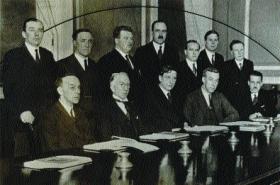
De Valera’s cabinet in 1932. De Valera did not consult them about the constitution, so tight was the drafting process.
Eamon de Valera came to power in 1932 as the head of a minority Fianna Fáil government. The writing of a new constitution and its subsequent endorsement by the Irish people on 1 July 1937, albeit by a narrow majority—685,105 for, 526,945 against—helped him to achieve many of his major policy goals. Paradoxically, his strategy was a vindication of the stepping-stone approach advocated by Michael Collins. De Valera used the freedom of office between 1932 and 1937 to achieve greater independence from Britain.
Was there anything wrong with the Irish Free State constitution of 1922? By objective standards, the document was very strong and served the country well. But de Valera and the anti-Treatyites objected vigorously throughout the 1920s to what they perceived as objectionable and repugnant clauses. Yet, once in power, de Valera did not set out immediately to draft a new constitution; he thought radical reform might suffice. He humiliated the governor-general and reduced his office to a very humble status, abolished the oath and undermined the role of the privy council. The decision to write an entirely new constitution was only taken in 1934 in the midst of an economic war with Britain.
Constitution Committee of 1934
Bunreacht na hÉireann may be described as de Valera’s constitution, although he lacked the legal skills to draft the document alone. He handed over that task initially to the Constitution Committee of 1934, a small body of civil servants: Stephen Roche, secretary of the Department of Justice; Michael McDunphy, assistant secretary, Department of the President; John Hearne, the legal adviser at the Department of External Affairs; and Phillip O’Donoghue, legal assistant to the attorney-general. The available evidence suggests that the calibre of those men was very high, that they were independent-minded, strong-willed, very experienced and entered upon their task with diffidence.
Their report was comprehensive; de Valera reviewed it on 30 April 1935, and two days later instructed Hearne to prepare draft heads for a new constitution. The choice of Hearne was not unusual: de Valera was also external affairs minister and had attended numerous League of Nations sessions with Hearne, who may have drafted the president’s notable 1932 speech at Geneva. Hearne had been heavily involved in drafting constitutional amendments early in de Valera’s first term of office.
On 18 May 1935 Hearne submitted draft heads of a constitution prepared on the president’s verbal instructions. In an explanatory memorandum he made clear his rationale: to include unassailable fundamental human rights that could only be suspended in an emergency; to ‘contain machinery for effectively preserving public order during any such emergency’; and to provide a presidency for the state, eliminating the governor-general and superseding the king in internal matters, while retaining the latter in international relations. These draft heads were in reality an attempt to modify the existing constitution. Arising from them were two major questions. The first was whether the new constitution should or could be enacted by the existing Oireachtas, and, if not, whether a constituent assembly should be called and, if so, how? The second was whether the draft heads violated the 1921 Treaty.
Although these questions went unanswered, the drafting of a new constitution proceeded into 1936. Again, very few were involved, with the official record noting that ‘the preparation of the original draft was done mainly by John Hearne, in consultation Phillip O’Donoghue . . . and the parliamentary draftsman, Mr [Arthur] Matheson, BL under the personal direction of the president’. De Valera was a regular visitor to the Hearne household, where both men worked late. While Hearne and his colleagues favoured a short document, it grew large and unwieldy.
There are two possible reasons for the enlargement of the original draft. It may have resulted from submissions of draft articles by the Irish province of the Jesuits, through Fr Edward Cahill, and, more substantially, owing to a deluge of material sent in by Fr John Charles McQuaid, a Holy Ghost Father from Blackrock College and future archbishop of Dublin. As strict secrecy surrounded the drafting process—with de Valera not even confiding in his cabinet—both sources could only have been made aware of the clandestine drafting process on de Valera’s personal authorisation. It is possible that the secretary of external affairs, Joseph Walshe, may also have been employed to act as a contact.
Cahill submitted a draft on 4 August 1936 that de Valera acknowledged in a return note on 19 September, doubting whether the material could be used but inviting more submissions. Other Jesuits, worried that Cahill alone among the Irish Society members would make submissions to de Valera, established a committee to draft a formal submission as the official presentation from the Irish province of the Jesuits. Cahill was appointed to the committee, along with some of the ‘best heads’ the order had ‘in matters of this kind’: P. Bartley acted as president, J. McErlean was secretary, and J. Canavan and E. Coyne were also appointed.
Influenced by the Polish constitution
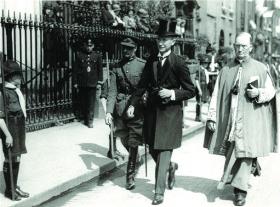
Governor-General James MacNeill about to enter the Pro-cathedral during the Eucharistic Congress in 1932. Note that he is all alone; there are no government ministers accompanying him. De Valera’s government snubbed MacNeill at every opportunity as part of the process of demeaning the office of governor-general. (Cork Examiner)
The committee first met on 24 September 1936. It decided, amongst other issues, to draft a preamble on the model of the Polish constitution. On 1 October it considered three draft preambles submitted by Cahill, Canavan and Coyne. At this meeting it approved, ‘with slight modifications’, an article on church and state drafted by Bartley. But drafting the article that declared that the state could not dissolve a valid marriage was difficult. Various attempts were made to find a satisfactory wording that would embrace all possible cases, and further consideration was held over until the next meeting, when drafts on private property and on freedom of conscience, of the press and of association were to be discussed.
On 8 October 1936 many drafts were considered and approved with slight modification. An article on church–state relations was passed with an addition proposed by Canavan. On Catholic marriage and the state, everyone except Canavan accepted Bartley’s draft. It was decided to include Canavan’s draft as an alternative. Bartley also drew up the articles on freedom of worship and freedom of the press. Canavan suggested an article on freedom of the cinema, radio, theatre and so forth, and it was decided to include it. The same control was to be exercised by law for these media as for the newspapers. A draft by Coyne on the family was approved. Coyne and Bartley drafted an article on parents and the education of children in schools. The article on religion in school was to be taken, with slight changes, from the Polish constitution.
The committee drew heavily on the Polish constitution, and on 11 October Bartley informed their provincial that their work would be concluded within a week. He proposed to hand over ‘our suggestions to Fr Cahill, who will deliver them in the proper quarter’. However, Bartley took precautions to ensure that Cahill, whose work thus far was ‘very harmonious’, could not veto anything of the committee’s work. He advised that:
‘Fr Cahill will almost certainly want to add recommendations of his own to those approved by the committee. Now these recommendations, partly by their sheer bulk and partly by their singular character, are likely to bring discredit on the very solid findings of the committee, especially if they are delivered at the same time as the committee’s findings.’
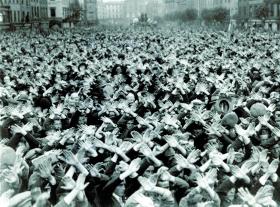
Members of the Irish Christian Front making the sign of the cross at a meeting in Grand Parade, Cork, 1936. The prospect of pressure from active Catholic bodies was always likely to influence calculations in relation to constitution-making in 1930s Ireland. (Cork Examiner)
Bartley suggested that Cahill be instructed that nothing be added to the committee’s work but that he would be free later to send in additional recommendations, provided they were approved by any two committee members. Bartley justified this ‘censorship’ because:
‘The source of Fr Cahill’s recommendations will be quite well known to a small number of very important people. The reputation of the Society will be involved; and the provincial has the right to watch over that reputation.’
Bartley had been entrusted with the job of controlling Cahill and preventing him from being too ‘singular’ in his ideas. Yet, contrary to expectations, Cahill played a passive role on the committee. He produced a draft preamble but did not make a substantial contribution to the drafting of any of the articles. It may have been that Cahill was aware of the ‘policeman’ role of the committee and determined to save his ideas for an individual submission. He obviously did not keep secret from Bartley the fact that he was preparing ‘voluminous recommendations’ for de Valera.
Meeting again on 15 October, the committee proceeded steadily. Bartley read the articles as amended ‘by previous decisions of the committee, together with a few additions and modifications handed in by Fr Cahill’. These changes were mostly verbal. In the article on private property, ‘the right to productive and non-productive property’ was outlined. The state was to aim at a wide distribution of private productive property, especially in land. The committee approved an article on private schools. Typed copies of the entire document were to be distributed to all members within a few days. They were at liberty to add any further comments they considered advisable, as well as references to existing foreign constitutions tending to confirm important clauses.
After the meeting Bartley informed the provincial that their work was finished; he was preparing the final report and Cahill was going to type it. They intended to meet again on Sunday 18 October to ‘give this report a final look over’. Bartley explained how he had told Cahill that the committee was ‘authorised by Your Reverence to deliver this report through him in the proper quarter’. Bartley told Cahill that the provincial had some instructions to give him regarding the report. ‘I did not profess to know’, Bartley wrote, ‘the nature of these instructions.’ However, Bartley advised that the instructions should be sent at once.
Preamble
Two days before the committee met for the last time on 18 October, the provincial wrote to Cahill, giving him exactly the same instructions as Bartley had recommended. All members of the committee were present at its final meeting on 18 October 1936. The preamble was changed slightly so as to read:
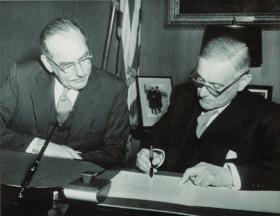
Hearne later became ambassador to Washington. He is seen here (right) signing the Double Taxation Agreement in December 1951 under the watchful eye of US Secretary of State Dean Acheson. (Irish News Agency)
‘In the Name of the Most Holy Trinity and of our Lord Jesus Christ, the Universal King, we the people of Ireland so full of gratitude to God who has so mercifully preserved us from innumerable dangers in the past; hereby, as an united independent Christian Nation, establish this Sovereign Society of the Irish people . . . and so in accordance with the principles laid down we freely and deliberately to the glory of God and honour of Ireland, sanction this constitution and decree and enact as follows.’
The committee agreed that references to the constitutions and concordats of Catholic states should be added to the various ‘assertions’ made in the document so ‘that those who have the task of drawing up the constitution may come to know what the Catholics of other European states have already secured’. Cahill was to type the document and submit it without any additions of his own. On 21 October 1936 Cahill wrote to de Valera, enclosing the committee’s preamble and articles:
‘I have, in drawing up the drafts which I am sending you, availed myself of the advice and assistance of three or four others, some of whom have made a special study of these matters; others, although not specialists, are pretty well informed on them, and are men on whose judgment I have confidence.’
Influence of John Charles McQuaid
Returning to John Charles McQuaid, the official biographers of de Valera, Professor T.P. O’Neill and the earl of Longford, accurately reflected McQuaid’s very influential role in the drafting of almost the entire constitution. McQuaid was particularly attentive to children at the time of the death of his brother, Brian, in a riding accident in February 1936, when he was a frequent visitor to the de Valera home at Bellevue.
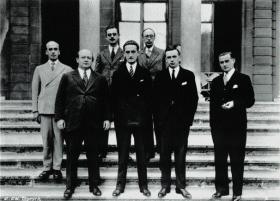
At the League of Nations, Geneva, 1931 (left to right, front row): Minister for Education J.M. O’Sullivan, Attorney-General John A. Costello and John Hearne, legal adviser to the Department of External Affairs. The original draft was largely Hearne’s work.
Presumably at de Valera’s invitation, McQuaid worked prodigiously on drafting the constitution. He supplied de Valera with learned notes on theories of authority, the family, marriage, Catholic social principles, private property and church–state relations. In the initial stages much of the material submitted was in the form of typed quotations from papal encyclicals. But as the drafting progressed, McQuaid was involved in the actual formulation of the articles dealing with personal rights, the family, education, private property, religion and directive principles of social policy (Articles 40–45 in the final draft). On the day that the constitution came into force, 29 December 1937, McQuaid wrote to de Valera: ‘This morning again I said Mass for you at dawn, on the eventful day. I am reminded all day of the text in the New Testament: “Many have desired to see what we see and have not seen”.’
That was certainly the case in the early months of 1937. McQuaid was privy to much of what de Valera was doing, as reflected in a letter of 17 February 1937, which indicated his level of involvement, to the point of criticisms of the draft submitted by Professor Alfred O’Rahilly, registrar of University College Cork. On 8 March 1937 McQuaid sent an amendment dealing with widows, orphans and the aged, emphasising the importance of the role of the family in the first instance and, interestingly, suggesting that a ‘mode of settlement’ for strikes would do much to neutralise ‘a great deal of the venom of communism’. When the proofs of the constitution became available on 9 March 1937, de Valera sent a copy to McQuaid, who took particular pride in ensuring that the inverted commas were in the right places. McQuaid replied: ‘Having been through the text very carefully, I append a few points for your kind consideration’.
McQuaid influenced by Fr Denis Fahy
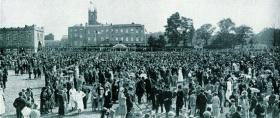
The garden party at Blackrock College during the Eucharistic Congress. The host, college principal Fr John Charles McQuaid, ensured that the papal legate and the governor-general did not meet on this occasion. (Sport and General)
But perhaps the topic that had taken up most of McQuaid’s time was the article on ‘Religion, Church and State’. His teacher and friend in religion, Fr Denis Fahey CSSP, very heavily influenced his thinking in this area. Fahey was not noted for his pioneering work in the world of ecumenism. Neither did he champion the cause of Christian–Jewish dialogue. Fahey represented a strand of theological thought that owed much to the besieged and beleaguered world of right-wing French Catholicism traumatised by the conflict between church and state at the beginning of the twentieth century. McQuaid was not quite as ‘singular’ in his views, but he shared Fahey’s hard-line position on the relationship between church and state. That triumphalist attitude found expression in the first draft Article 42, ‘Religion, Church and State’.
This draft article was remarkably similar, in structure and content, to McQuaid’s submission, and may lead one to speculate whether in fact the Holy Ghost priest was not himself the author. There is an earlier draft that had been worked on by de Valera, who changed the title of the article to ‘Church and State’. There were other minor amendments made by the president but no change in substance.
Blending of the old and the new
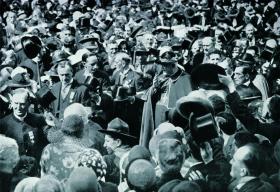
The papal legate, Cardinal Lauri, at the garden party, attended by approximately 10,000 people. (Daily Express)
What emerged as a first draft was the result of enormous energy and effort. The content was a blending of the old and the new. There were significant changes in both substance and form from the 1922 document, not just a mere ‘re-bottling’. The document was self-consciously nationalist, strongly Catholic in tone and republican in aspiration. The influence of Catholic thinking was very evident. But there were liberal and conservative currents within that tradition. In the case of the article on religion, de Valera had allowed the more conservative trend to dominate. That was a serious difference from the corresponding Article 8 in the 1922 constitution.
In early 1937 de Valera established an editorial committee under the chairmanship of Maurice Moynihan, whose brother, Seán Moynihan, was secretary to the executive council (cabinet); Maurice would soon replace him in that post. De Valera, recognising the talent and judgement of Maurice Moynihan, seconded him to act as chairman-editor and gave him a small team. Moynihan quickly brought the document to the stage where it could be sent to the printers. Somebody, possibly Moynihan, must have pointed out to de Valera the unsuitability of the draft article on religion. Others may also have made the same objection. It was removed from the copy circulated on 16 March 1937 although it had been present in an earlier version sent to a very small group of de Valera’s inner circle. McQuaid did not object to this, by letter anyway. He wrote to de Valera on 16 March: ‘I am deeply grateful for the draft. It is such a joy to see it in print; now it remains to see it enacted. It reads very well. I think I note the few changes made.’
On 12 March 1937 the executive council discussed the general procedure in regard to the enactment of the new constitution. It was agreed that the draft should be submitted to Dáil Éireann for approval, the procedure for its consideration by the Dáil being that applicable to a bill. If approved by the Dáil, the draft would be submitted to a plebiscite to be held at the same time as a general election. It was also agreed that the constitution would come into operation either on the day following the expiry of a six-month period or on an earlier day as might be fixed by a resolution of the chamber of deputies elected at the general election on the polling day, which was to be the same day as the plebiscite. Authority was given to prepare legislation for the plebiscite. According to Seán MacEntee, de Valera was given a mandate by the executive council to secure a formula on religion that would stop far short of establishing the Catholic Church.
Shuttle diplomacy
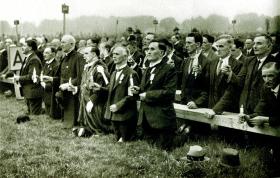
Members of the Dáil and Senate attend the Eucharistic Congress in the Phoenix Park. (Central Press)
On 16 March the printed text was distributed confidentially to members of the executive council and to other selected persons, including the president of the high court, Conor Maguire, high court judge George Gavan Duffy, and supreme court judge James Geoghegan. De Valera invited reaction from government departments and from his colleagues. That process proceeded and the text was changed in response to various comments and criticisms. But there was a major problem with the article on religion. There was definite opposition within the executive council to what had been drafted. Unless the matter was resolved amicably, divisions might result in a church–state crisis and the popular rejection of the constitution. De Valera set out on a programme of shuttle diplomacy to secure consensus from the churches.
Between 3 April and 27 April he consulted, directly or indirectly, the papal nuncio, the cardinal, the Roman Catholic and Church of Ireland archbishops of Dublin, the moderator designate of the Methodist Church and a number of other intermediaries. Also, on 16 April Joseph Walshe was sent to Rome to show the content of the controversial article to senior officials at the Holy See and, if possible, to Pope Pius XI. He had with him a set of detailed instructions and the draft religious article, which had been transformed as a consequence of de Valera’s discussions with the heads of the churches. Walshe returned to Dublin with the good news that the Holy See would remain neutral on the wording of the religious article.
Agreement had been found on the wording of the contested religious clause, which was now numbered Article 44. With the religious article taken care of, the way was open for the publication of the document on 1 May. It received its second reading in the Dáil on 11–13 May, before being approved by the Dáil on 14 June on a vote of 62 to 48. It was enacted by the people on 1 July 1937. Despite the unpopularity of the economic war, de Valera also succeeded in returning Fianna Fáil to power. He had risked campaigning on the new constitution more than on the record of his party. The constitution was given great importance at the hustings. On Constitution Day, 29 December 1937, Bunreacht na hÉireann came into operation.
A very risky political strategy
By seeking to draft a new constitution, de Valera had embarked upon a very risky political strategy. Irish political life in the mid-1930s was very volatile. There were extremes of left and right, represented by revolutionary republicans in the IRA and the residue of the Blueshirts. Yet he succeeded in presiding over the drafting of a document of enduring value. It might have been of even greater and more enduring value if he had prevented a strong imprint of contemporary Catholic thinking from being written into the text.
The singular influence of Fr John Charles McQuaid was very pronounced. He did not get his way on the religious article but that should not deflect attention from his successes in other areas. De Valera would have been much more prudent to have listened to the advice of John Hearne and his civil service colleagues, who favoured the drafting of a shorter and more essentialist document. However, the constitution did not ingest any of the extremism of the 1930s. Thanks to the measured judgement of John Hearne and his small drafting team, the Irish constitution has had an enduring value.
Dermot Keogh is Professor of History and Andrew McCarthy lectures in history at University College Cork.
Further reading:
B. Farrell (ed.), De Valera’s constitution and ours (Dublin, 1988).
G. Hogan, ‘The Constitution Review Committee of 1934’, in Fionán Ó Muircheartaigh (ed.), Ireland in the coming times (Dublin, 1997).
D. Keogh, ‘The Irish constitutional revolution: an analysis of the making of the constitution’, in Frank Litton (ed.), ‘The Constitution of Ireland, 1937–1987’, Administration 35 (4) (1988).
D. Keogh, ‘The Jesuits and the 1937 Constitution’, Studies 78 (309) (1989).
This article is relevant to the ‘from Free State to Republic’ element of topic 3 (‘The pursuit of sovereignty and the impact of partition, 1912–1949’) of the later modern Ireland field of study (1815–1989) of the Southern Leaving Certificate syllabus.
















